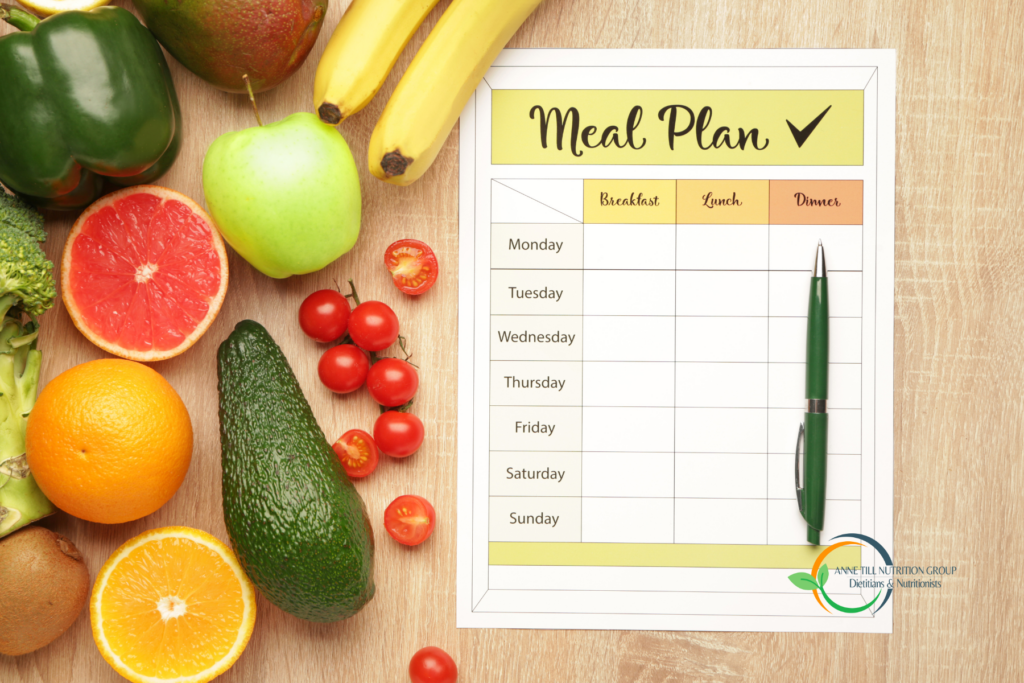
Nikki Kuhlmann
RD, LDN
The Benefits of Meal Planning and Prepping
Meal planning and prepping can be a game-changer for anyone trying to eat healthier, save time, and reduce stress around mealtime. With a little strategy, you can set yourself up for success without spending hours in the kitchen. Not only does it help with portion control and budgeting, but it also reduces food waste by ensuring you use up ingredients efficiently. Additionally, having prepped meals on hand makes it easier to stick to a nutritious diet, even on the busiest days.

How to Plan Your Meals for the Week
Start by deciding how many meals you need for the week. Consider your schedule—are there nights when you’ll be eating out or too busy to cook? Keep those in mind as you plan. Balance your meals with proteins, vegetables, whole grains, and healthy fats. To simplify meal planning, assign each day a theme, such as Meatless Monday with veggie stir-fry or lentil soup, Taco Tuesday with chicken lettuce wraps or shrimp tacos, and Slow Cooker Thursday with shredded salsa chicken. Leftover Friday is a great way to get creative and use up ingredients from earlier in the week to avoid waste. Planning meals around seasonal produce can also help keep meals fresh and budget-friendly.
Another useful technique is meal mapping, where you identify a few key ingredients that can be used in multiple meals. For example, a large batch of grilled chicken can be used in salads, wraps, and stir-fries throughout the week. Similarly, roasted vegetables can be repurposed into grain bowls, omelets, and soups.
Creating an Efficient Grocery List
Once your meals are planned, create a grocery list based on what you already have and what you need. Organizing your list by category—produce, protein, dairy, and pantry—makes shopping more efficient. To further streamline the process, arrange your list in the order you walk through the store to save time. Buying versatile ingredients, such as spinach, eggs, and chicken, allows for flexibility in meal options. Keeping pantry staples on hand, like canned beans, whole grains, nuts, and spices, ensures you can whip up a meal even if plans change.
Consider using grocery shopping apps to save time and track spending. Many apps allow you to save your favorite grocery items and reorder them quickly. If you’re short on time, grocery delivery or pick-up services can be a convenient option. Some sample grocery list items for quick meal prep include pre-cut vegetables, frozen fruit, rotisserie chicken, Greek yogurt, whole-grain wraps, canned beans, brown rice, eggs, nuts, hummus, and low-fat cheese.
Prepping Ingredients in Advance
Dedicating time—whether it’s an hour on Sunday or a few minutes each evening—to prepping ingredients in advance can make meal assembly quicker throughout the week. Washing and chopping veggies, marinating proteins, and cooking staple items like rice or beans can save time. Pre-cut vegetables, frozen fruits, canned beans, and cooked grains are great shortcuts to minimize prep work without sacrificing nutrition. Opt for low-sodium and no-added-sugar options when choosing canned goods.
Some easy meal prep ideas include grilling or baking a batch of chicken breasts for salads and wraps, hard-boiling eggs for snacks, and portioning out yogurt with fruit for quick breakfasts. Prepping smoothie bags by combining frozen fruit, protein powder, and greens in individual freezer bags makes mornings effortless. Additionally, cooking a large batch of quinoa or brown rice and storing it in portioned containers ensures a quick base for various meals throughout the week.
The Power of Batch Cooking
Batch cooking is another time-saving strategy. Making double portions of meals allows you to repurpose leftovers for another meal, reducing cooking time and preventing food waste. For example, grilled chicken can be used in salads, wraps, sandwiches, or stir-fries; roasted vegetables can be tossed into omelets, grain bowls, or pasta dishes; and slow cooker chili can be served with rice one night and then used in tacos or stuffed peppers the next.
One-pot and sheet pan meals also minimize dishes and allow for hands-off cooking, making dinnertime more convenient. If you have a slow cooker or Instant Pot, consider using it to prepare large batches of soups, stews, or shredded meats, which can be divided into multiple meals throughout the week.
Storing and Freezing Meals for Convenience
Storing meals in portioned containers helps with easy grab-and-go options. Label meals with dates and organize them so the ones that need to be eaten first are up front. Using glass or BPA-free containers keeps food fresh longer. Freezer-friendly meals, such as soups, casseroles, and marinated proteins, offer backup options for busy days, and freezing items in individual portions makes reheating easier. Investing in quality freezer bags and airtight containers can help preserve food freshness and prevent freezer burn.
Quick and Nutritious Backup Meal Ideas
Despite the best plans, life happens, and sometimes meal planning doesn’t go as expected. Keeping quick and nutritious options on hand can be a lifesaver. Some easy go-to meals include rotisserie chicken with frozen veggies and microwavable brown rice, canned tuna or salmon mixed with avocado or Greek yogurt on whole-grain toast, or a protein smoothie with frozen fruit, protein powder, and almond milk. Keeping a list of 5-10 quick meals that require minimal prep and ingredients can help you stay on track and avoid ordering takeout.
Stocking up on freezer-friendly items like frozen vegetables, pre-cooked grains, and protein-rich options like shrimp or turkey burgers allows for quick meal assembly. Additionally, having simple ingredients like eggs, cheese, and whole-grain wraps on hand means you can always make a quick omelet or quesadilla in minutes.
Final Thoughts
Meal planning and prepping don’t have to be overwhelming. By using themes, batch cooking, and taking advantage of shortcuts like frozen ingredients and one-pan meals, you can save time while still eating nutritious, homemade meals. Start with small, manageable changes, such as prepping a few ingredients in advance or cooking a double batch of your favorite meal. As you get more comfortable, refine your system to suit your lifestyle and dietary preferences. Try implementing just one or two of these strategies this week and build from there!
Call Us Today: 919-990-1130





